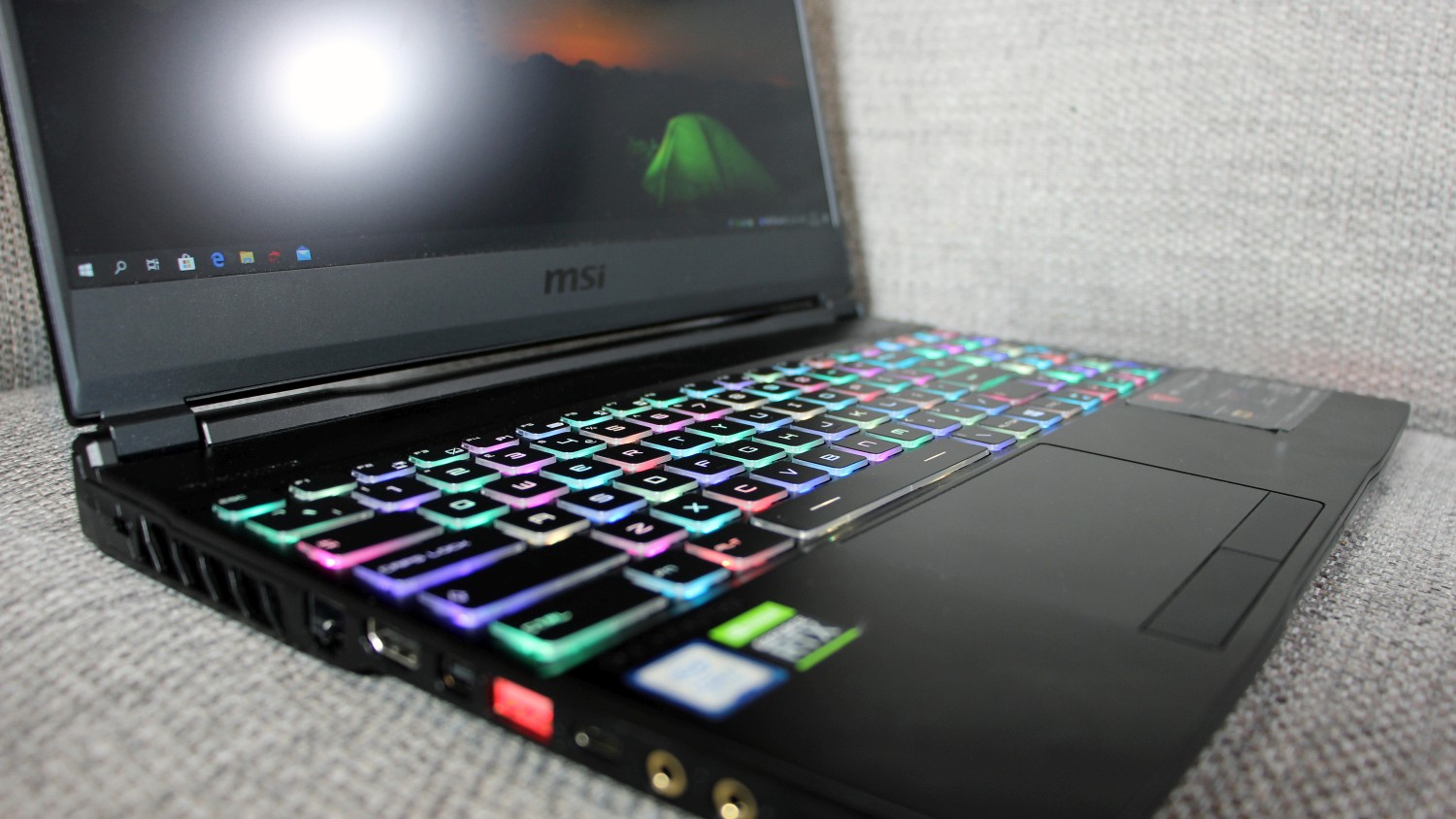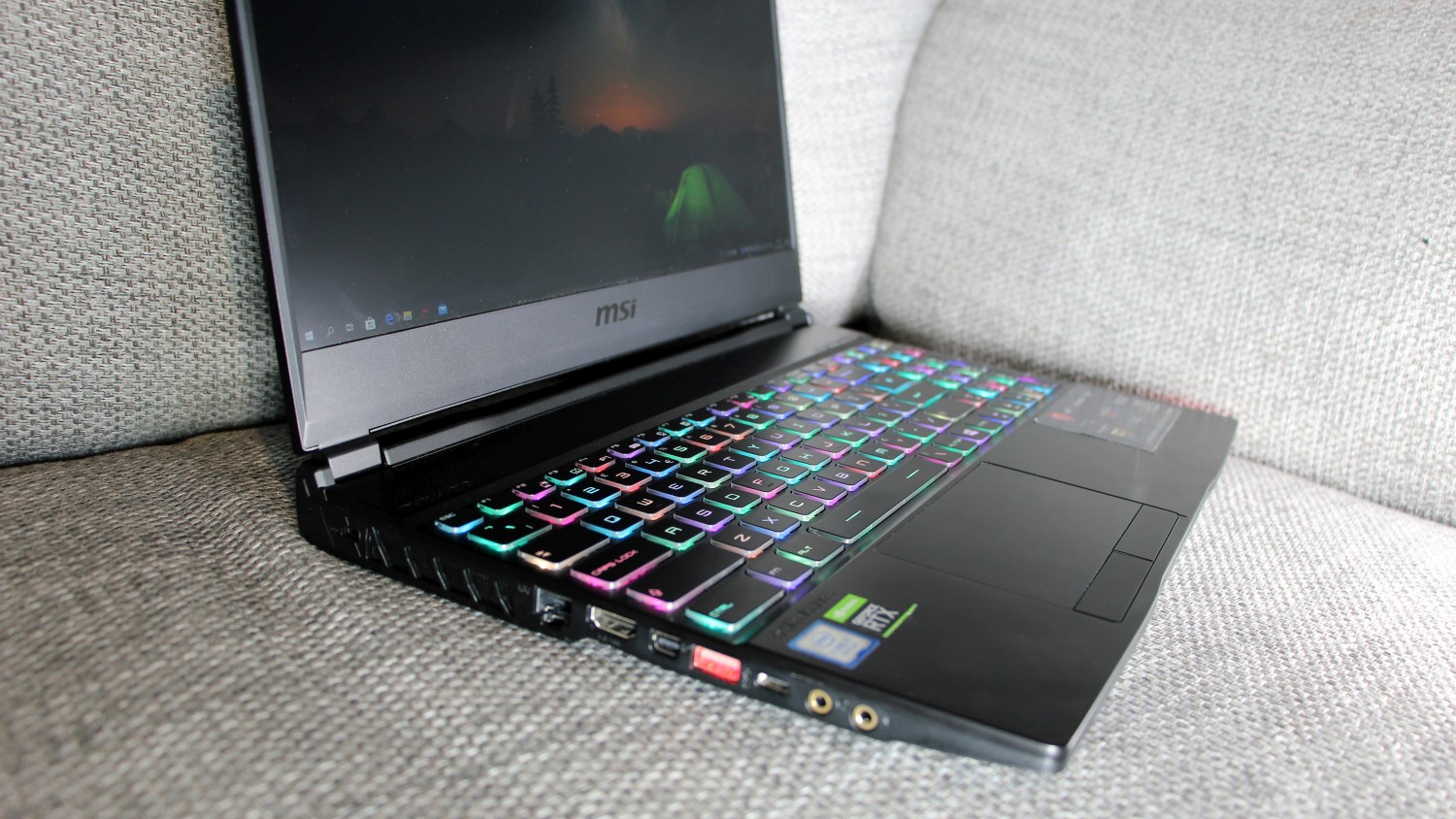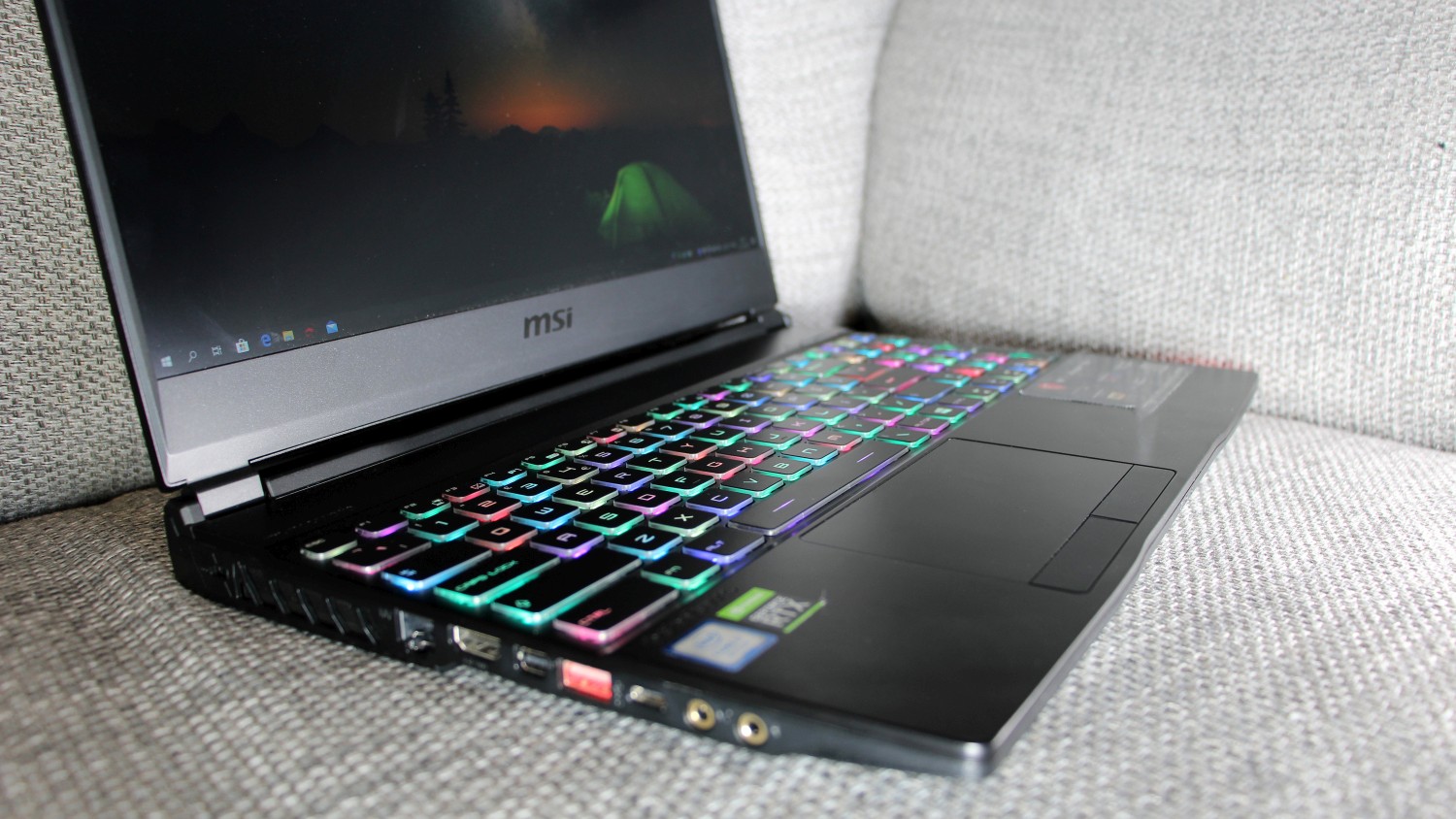TechRadar Verdict
The MSI GE65 Raider 9SF doesn’t look as good as its rivals, but it has huge power levels for work and play – alongside good ergonomics and a great 240Hz screen.
Pros
- +
Great gaming and application performance
- +
Smooth, impressive 240Hz screen
- +
Decent keyboard and loads of ports
Cons
- -
Outdated design
- -
Disappointing battery life
- -
Mediocre speakers
Why you can trust TechRadar
Two-minute review
The MSI GE65 Raider is a beast, with a 240Hz screen, an eight-core Intel Core i9 CPU and an RTX 2070 GPU.
It squares up against the Razer Blade, which offers similar specifications and high-end design.
The 240Hz screen is a stunner, and the huge refresh rate is ideal for esports – because motion is smoother and sharper. Conventional 144Hz displays are still good, but the jump to 240Hz provides a noticeable improvement if you’re chasing every advantage.
The contrast level of 1,137:1 makes games look punchy, and the Delta E of 1.82 means good accuracy. The color temperature of 7,614K is too cool, and lends images a slight blue pall. However, it’s not a noticeable problem during frantic gameplay.

On the inside, there’s a full-power mobile Nvidia GeForce RTX 2070. It’ll play any popular esports game at the speeds required for that screen. It’ll also handle tougher triple-A games at speeds of beyond 60fps.
The Intel Core i9-9880H processor is fast, but it’s only useful if you need a machine for tough work. If you don’t need that, save money with a Core i7 version.
Elsewhere, there’s 32GB of memory, a 1TB SSD and future-proofed 802.11ax wireless.
Sign up for breaking news, reviews, opinion, top tech deals, and more.
Razer’s competing machine has a 240Hz screen, but its equivalent still costs $2,450 (£2,120, around AU$4,299) and uses an RTX 2070 Max-Q – so you’ll lose between ten to twenty frames in games.
The Razer is available with an RTX 2080 Max-Q – which offers the same speed as the MSI’s GPU. However, that pushes the Razer’s price up to $2,700 (£2,610, around AU$5,000).
The MSI GE65 Raider 9SF's SteelSeries keyboard is reasonable, with a decent amount of travel and quiet, comfortable operation – good enough feel too heavy. A USB mouse will be far better.
The MSI GE65 Raider 9SF has three illuminated USB 3.2 ports and a Type-C connection alongside HDMI, mini-DisplayPort, two audio jacks and even an SDXC card reader.
When it comes to design, the MSI GE65 Raider 9SF looks dated, and the body is littered with odd textures. It also feels chunky, weighing 4.9 pounds (2.2kg) and is just over an inch thick. Many modern gaming laptops are able to combine sleek and stylish designs with lightweight, yet sturdy build quality, and powerful components.
Speaking of build quality, the MSI GE65 Raider 9SF loffers a mixed bag: the screen is sturdy but there’s too much give in the base.
In our opinion, Razer’s machine is sturdier, slimmer and better-looking.
Unfortunately, the MSI GE65 Raider 9SF suffers in battery tests, too. This laptop lasted two and a half hours in our movie test, two hours in PC Mark and just over an hour when gaming. The Razer has twice the longevity.
In the end, the MSI GE65 Raider 9SF is not good-looking or long-lasting – the Razer Blade is undoubtedly better. However, the MSI GE65 Raider 9SF l has a smooth, punchy screen and more internal power than its rival. So, it’s a worthwhile option for smooth gaming, high-end esports and tough work.
Price and availability
Here is the MSI GE65 Raider 9SF-231UK configuration sent to TechRadar for review:
CPU: 2.3GHz Intel Core i9-9880H (8-core, 16MB cache)
Graphics: Nvidia GeForce RTX 2070
RAM: 32GB DDR4
Screen: 15.6-inches, 1,920 x 1,080 non-touch 240Hz IPS
Storage: 1TB SSD
Optical drive: No
Ports: 2 x USB 3.2 Gen 2, 1 x USB 3.2 Gen 2 Type-C, 1 x USB 3.2 Gen 1, 2 x audio, 1 x HDMI, 1 x mini DisplayPort, 1 x SDXC
Connectivity: Dual-band Wireless 6, Gigabit Ethernet, Bluetooth 5.1
Camera: 720p Webcam
Weight: 4.9 pounds (2.2kg)
Size: 1.06 x 14.1 x 9.7 inches, 27 x 358 x 248mm (H x W x D)
The MSI GE65 Raider 9SF is not cheap – it’ll set you back a whopping $2,735 (£2,200, around AU$4,450).
You do get plenty for your money, though. It’s got that 240Hz screen, an Intel Core i9 CPU and a full-power mobile RTX 2070 GPU alongside great storage, memory and networking.
It’s also not a bad deal when compared to its main rival – the Razer Blade. For an equivalent specification you’ll have to pay out $2,450 (£2,120, around AU$4,299). That’ll get you a 240Hz screen, but a weaker Core i7 CPU and a slower RTX 2070 Max-Q GPU.
The Razer is also available with an RTX 2080 Max-Q that offers similar performance to the MSI GE65 Raider 9SF’s RTX 2070, but its price rises to $2,700 (£2,610, around AU$5,000).
The MSI GE65 Raider 9SF is not a bad deal at all: it offers more power than its main rival for a similar price.
There are also options if you want a GE65 Raider but don’t want to spend so much – if you don’t need a Core i9 CPU or an RTX 2070, for instance. A model with an RTX 2060 GPU and a Core i7 CPU will still motor through esports games with the speeds required to handle the 240Hz screen, and it costs $1,700 (£1,610, around AU$3,267).
Design

The MSI GE65 Raider 9SF may be better value than its rival from Razer, but the lower price can be explained by the GE65’s design.
It’s not awful, but this laptop feels outdated compared to its more stylish competitors. The lid and base section are decorated with slashed metal and random textured sections, and the rear has ostentatious air vents.
When compared to the sleek, subtle Razer, there’s only one winner when it comes to aesthetics.
The MSI GE65 Raider 9SF is only middling when it comes to its build quality and dimensions, too. The GE65 weighs 4.9 pounds (2.2kg) and is just over an inch thick – roughly the same weight as the Razer, but about a third thicker.
Meanwhile, the MSI GE65 Raider 9SF's screen is sturdy, but the metal used to build the base has too much flex. It’s a little weaker than the Razer, and we’d recommend using an external sleeve to safeguard this machine when you’re away from home.

This machine is better in practical aspects. It’s got three full-size USB 3.2 ports, and they’re all illuminated so they can be seen in the dark. It’s also got HDMI and mini-DisplayPort outputs, two audio jacks, a USB Type-C connection and even an SDXC card slot. Thunderbolt isn’t included, though.


The MSI GE65 Raider 9SF also has a decent keyboard. The SteelSeries-made unit is a chiclet design, and it has reasonable quality: a solid amount of travel, a fast and consistent typing action and a firm base.
The keyboard used here has more travel than the buttons on the Razer unit, so it’s a little more satisfying and useful for mainstream gaming and esports. The MSI GE65 Raider 9SF's keyboard also has per-key RGB LED backlighting, so a huge amount of customisation is possible. It’s also got a numberpad – something the Razer Blade didn’t include.
As ever, though, beefier gaming laptops tend to have more travel. It’s even possible to find machines with mechanical hardware. Those will offer more speed and snap and a more satisfying typing experience.

The trackpad itself is fine, but the two buttons are a little too heavy – which means they’re not conducive to fast-paced gameplay. A USB mouse will be far better.
The MSI GE65 Raider is not perfect when it comes to its design, then, but there’s still lots to like here: the keyboard is good and there are plenty of ports.
Just be aware that the rival Razer machine is sleeker, sturdier and more stylish – no surprise considering it’s a newer design.
Performance
Here’s how the MSI GE65 Raider 9SF performed in our suite of benchmark tests:
3DMark: Night Raid: 37078; Fire Strike: 17193; Time Spy: 7384
Cinebench CPU: 3314 points
GeekBench 5: 1,153 (single-core); 6,284 (multi-core)
PC Mark 10 (Home test): 5273
PC Mark 10 battery life: 2hrs and 4 minutes
Battery life (techradar movie test): 2 hours and 33 minutes
Total War: Three Kingdoms: (1080p, Ultra): 64.2; (1080p, Low): 158.6 (turbo 66.2/181) (comfort 63.9/181.3)(eco 24.8/59.4)
Red Dead Redemption II: (1080p, Ultra): 72.3; (1080p, Low): 96.2
The speakers are mediocre. They’re very loud, and they do have bass – but those deeper tones don’t have much detail. Similarly, the mid-range is muddy, and the top-end is weak. These speakers are passable, but the Razer Blade is better here and a headset will be better still.
The MSI GE65 Raider 9SF is powered by RTX 2070 graphics. It’s Nvidia’s full-power mobile version, which means it has 2,304 stream processors, 8GB of GDDR6 memory and a boost clock of 1,440MHz. It’s a step beyond the RTX 2070 Max-Q core that’s used in rivals, including the Razer. That cut-back product has a peak speed of 1,185MHz.
The RTX 2070 easily has the power to run all of today’s most popular esports games at beyond 200fps – speeds required to make the most of that screen. It’s also fast enough to handle tougher single-player games at a smooth 60fps.

The Razer’s RTX 2070 Max-Q will be about ten to twenty frames behind in most gaming situations.
The MSI GE65 Raider 9SF's GPU is joined by an Intel Core i9-9880H processor. It’s one of Intel’s beefiest mobile CPUs – it has eight multi-threaded cores, 16MB of cache, and base and boost speeds of 2.3GHz and 4.8GHz.
Unsurprisingly, the processor motored through benchmarks. Its Cinebench CPU score of 3,314 points is around 400 points beyond the Core i7-9750H that’s included in most gaming laptops, including the Razer. Its Geekbench multi-core score of 6,284 points is around 500 points better.
It’s a huge amount of power, but it’s only needed if you want to do tough work, like photo-editing and video-encoding. If you do, great – if not, save cash by opting for a Core i7 model.
Similarly, you only need this machine’s 32GB of memory for work – games will be sated by 16GB.
The MSI GE65 Raider 9SF rounds out its specification with a 1TB SSD, future-proofed WiFi 6 and Gigabit Ethernet.

This machine has numerous performance modes, but don’t rely on these for a boost. Turbo mode improved its gaming performance by a frame or two, but had no impact on CPU tests. Its Comfort option reduced performance slightly without much impact on thermals, and its Eco mode sliced performance levels in half.
The MSI GE65 Raider 9SF isn’t a bad thermal performer, no matter what mode used. During tough gaming situations the GE65 does make noise, but it’s easy to manage – a headset will take care of it, and it’s no louder than the Razer. The internal temperatures are fine, too.

And then there’s the screen. The 240Hz refresh rate is fantastic: easily high enough to make the most frantic games look smooth, sharp and clear. There’s no sign of motion blur, and the fastest action is rendered with precision.
There’s not a massive gulf between more common 144Hz displays and this 240Hz panel – those slower refresh rates will still be easily good enough for esports. However, you do still gain smoothness and sharpness from taking the step up to 240Hz. If you’re a high-level esports player looking for every advantage, it’s a decent upgrade.
The screen’s contrast ratio of 1,137:1 is punchy and delivers decent vibrancy, and its black level of 0.27cd/m2 is just about good enough to make darker areas in games look absorbing.
The screen’s Delta E measurement of 1.88 is good – it ensures colors are rendered accurately. The panel can render 92.8% of the sRGB gamut, which is enough to handle the vast majority of shades that games require. The backlight variation of 10% is better than most laptops manage, too.
The only issue is the color temperature of 7,614K. That’s on the cool side, and it means that lighter areas have a slight blue tinge. Thankfully, it’s not too noticeable during gaming.
The Razer does have a little more punch and vibrancy, but this panel is still very good.
Battery life

Don’t expect much when it comes to battery life. The MSI GE65 Raider 9SF just about made it through a movie, but it only lasted for just over an hour when tasked with handling a tough game. If you want a proper gaming session on this machine, you’ll need to plug in. You also can’t use the MSI’s Turbo performance mode unless it’s powered.
The Razer machine lasts for around twice as long across all tests – not long enough for a decent gaming session, but a better result if you want to get some work done, or if you want to use that lengthier, slimmer machine on your commute.
The MSI GE65 Raider 9SF isn’t really designed to do much travelling, and it’s certainly better when it’s attached to the mains.
Buy it if...
You need a machine for work and play
The inclusion of an RTX 2070 graphics core, an eight-core CPU and 32GB of memory mean that the MSI can handle virtually anything: it’ll run toughest games and the vast majority of work applications with more aplomb than most rivals.
You want to perfect your esports game
The 240Hz screen is smoother and faster than almost anything else, and the RTX 2070 GPU has the grunt to handle games at those speeds. If you’re a committed esports player, you’ll appreciate this panel’s flawless, crisp rendering in fast-paced situations.
You do lots of typing
The SteelSeries keyboard is good for work and play, and a little better than the shallower unit on the Razer Blade. That makes it very satisfying for hammering through work documents as well as for mainstream games.
Don't buy it if...
You want a slim, good-looking laptop
The MSI GE65 Raider 9SF is not a bad-looking machine, but its design is now looking dated. Rivals like the Razer Blade are better-looking, and they’re much slimmer too – which makes them smarter and easier to carry around.
You need great battery life
The MSI GE65 Raider 9SF only lasted for a couple of hours in even our weakest benchmark, so this isn’t an ideal machine for long stints of gaming or work on the road. It’s at its best when it’s plugged in.
You don’t need a machine for work as well as play
The Core i9 processor is great, but it’s unnecessary for gaming – a Core i7 chip will be just as good here. If you don’t need a machine work, you can save money by eschewing a Core i9 CPU.
Mike has worked as a technology journalist for more than a decade and has written for most of the UK’s big technology titles alongside numerous global outlets. He loves PCs, laptops and any new hardware, and covers everything from the latest business trends to high-end gaming gear.
